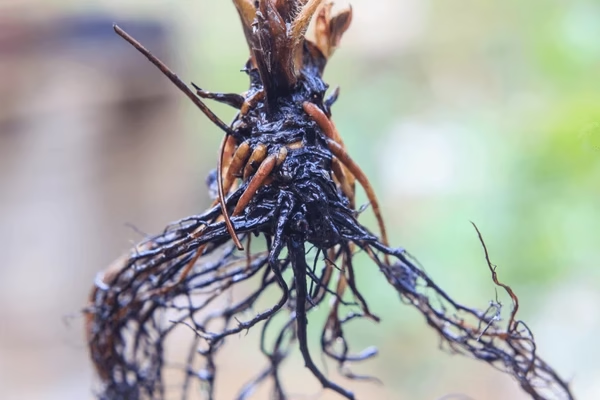Root rot is one of the most common and destructive issues that houseplant owners face. It occurs when roots become waterlogged, leading to decay and plant failure. Preventing root rot is crucial for maintaining healthy, thriving houseplants. In this guide, we’ll explore how to prevent root rot in houseplants with effective tips and best practices.
Table of Contents
What is Root Rot?
Root rot is a disease caused by fungi and bacteria that occurs when plant roots are exposed to too much moisture for an extended period. This excess moisture leads to a lack of oxygen in the soil, causing the roots to decay and become mushy and black. Once root rot develops, it can spread rapidly, making it challenging to save the affected plant. If not addressed promptly, root rot can severely damage the plant’s root system, resulting in irreversible harm.
Signs of Root Rot in Houseplants
Identifying root rot in houseplants early can help you take action before it’s too late. Here are some common signs:
- Yellowing leaves – Leaves start turning yellow or brown due to insufficient nutrient uptake.
- Wilting despite moist soil – The plant appears weak and droopy even when the soil is damp.
- Mushy or black roots – Healthy roots should be firm and white; rotten roots turn dark, soft, and mushy.
- Foul smell from soil – A strong, musty odor indicates bacterial and fungal growth.
- Leaf drop – The plant may start shedding leaves as it struggles to sustain itself.
- Mold or fungal growth on the soil surface – Excess moisture encourages mold growth, which is a warning sign of poor drainage and potential root rot.
- Slow or no growth – Plants affected by root rot will often stop growing due to a lack of nutrients.
- Soft, soggy stems – In advanced cases, the rot spreads to the stems, making them soft and easy to break.
- Brown, dry patches on leaves – Root damage can cause irregular water distribution, leading to dry, crispy patches on leaves.
- Sudden plant collapse – In severe cases, the plant may completely collapse as the root system fails.

How to Prevent Root Rot in Houseplants
1. Use Well-Draining Soil
Proper soil selection is key to preventing root rot. Choose a well-draining potting mix that allows excess water to escape quickly.
Example: A mix containing peat moss, perlite, and pine bark helps improve aeration and drainage.
2. Ensure Proper Drainage
Always use pots with drainage holes to allow excess water to escape. Avoid decorative pots without drainage unless using a plastic liner with holes inside.
Example: Terracotta pots are excellent for moisture control because they absorb excess water from the soil.
3. Water Wisely
Overwatering is the leading cause of root rot. Water your plants only when the top inch of soil is dry. Stick to a consistent watering schedule based on plant needs rather than watering on a set timeline.
Example: Succulents and cacti need watering only every two to three weeks, while ferns prefer consistently moist soil but not soggy.
4. Improve Air Circulation
Good airflow around the plant and soil surface prevents excess moisture buildup and discourages fungal growth.
Example: Avoid crowding plants too closely together, and occasionally use a fan in humid environments to enhance air circulation.
5. Repot When Necessary
Old, compacted soil retains too much moisture and should be replaced periodically. Repot your houseplants with fresh soil every 1-2 years to maintain proper drainage.
Example: A Monstera plant can benefit from repotting into fresh, chunky aroid mix every 1-2 years to keep roots healthy.
6. Avoid Letting Plants Sit in Water
Never allow excess water to collect in saucers or cachepots. Empty any standing water after watering to prevent prolonged root exposure to moisture.
Example: If using a decorative outer pot, ensure the inner nursery pot is elevated on pebbles to prevent sitting water contact.
7. Treat Early Signs of Root Rot in Houseplants
If you suspect root rot in houseplants, act quickly by removing the plant from the pot, trimming affected roots, and repotting in fresh soil. Use a fungicide or cinnamon powder to treat remaining healthy roots before replanting.
Example: If a Pothos plant shows root rot symptoms, remove the damaged roots, allow the remaining roots to dry slightly, and repot in a well-draining mix.
8. Use Proper Watering Techniques
When watering houseplants, always pour water evenly over the soil rather than focusing on one spot. Water deeply but infrequently to encourage healthy root development.
Example: Watering from the bottom by placing the pot in a shallow dish of water allows the roots to absorb moisture naturally, reducing the risk of overwatering.



Top On Sale Product Recommendations!
2PC Plant Watering Globes Iridescent Gradient Color Clear Mushroom Self-Watering Spikes Plant Watering Bulbs Devices For Indoors
Price Now: EUR 15.69
Click & Buy:
9. Avoid Using Contaminated Soil
Reusing old soil that previously held a plant affected by root rot can introduce harmful bacteria and fungi to healthy plants. Always use fresh, sterilized soil when repotting.
Example: If your Peace Lily suffered from root rot, discard the old soil and clean the pot thoroughly before adding new potting mix.
Conclusion
Proper watering, good drainage, and routine plant care are essential for preventing root rot in houseplants. By following these essential tips, you can keep your houseplants healthy and thriving. Always monitor your plants closely for early signs of trouble and adjust care routines as needed to maintain optimal soil moisture.
For more houseplant care tips, subscribe to our newsletter and keep your indoor jungle flourishing!
